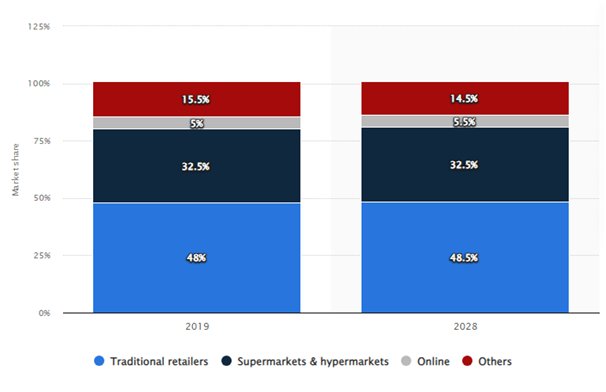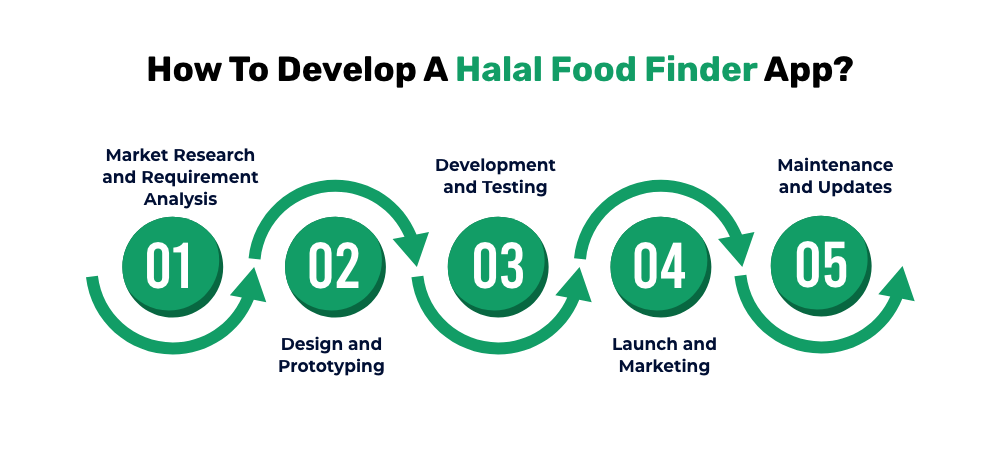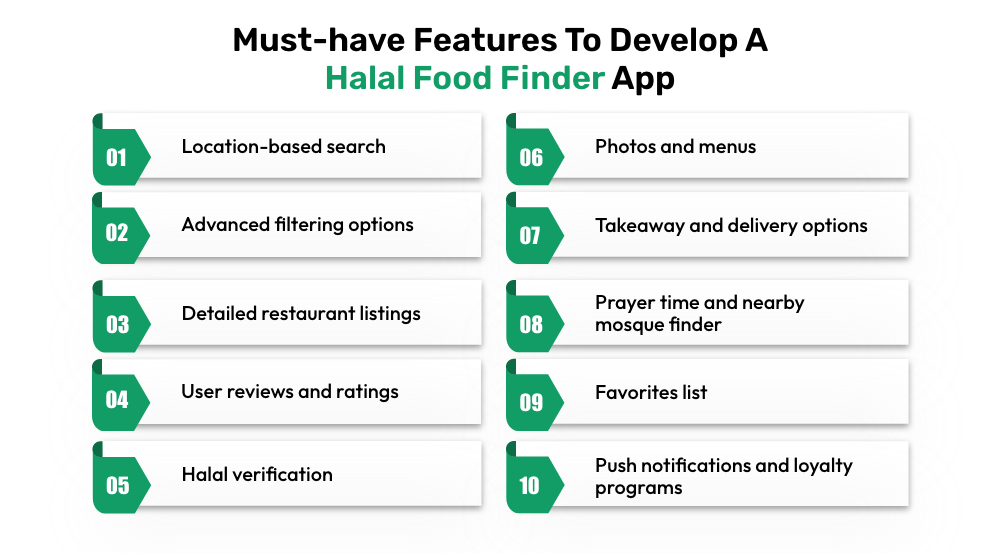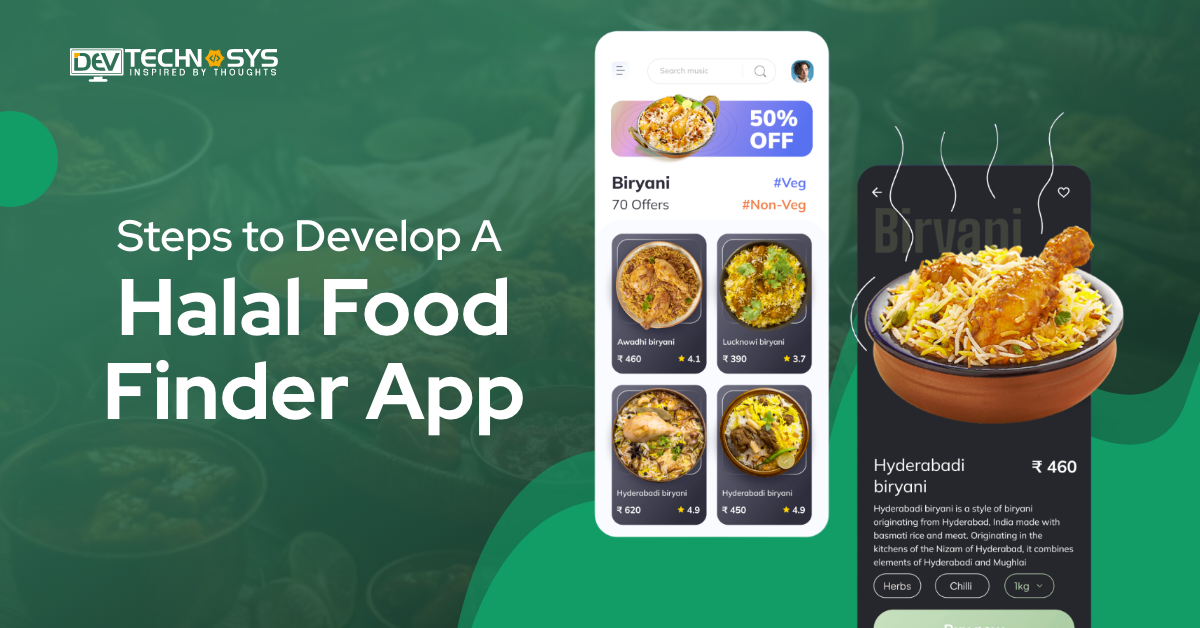Are you looking to develop a halal food finder app? If yes, then you have reached the correct place. In today’s globalized world, finding food that adheres to religious dietary restrictions can be a challenge. For Muslim communities, halal food options are a necessity.
To bridge this gap, halal food finder apps are becoming increasingly popular. These apps empower users to locate restaurants, grocery stores, and other establishments that cater to halal dietary needs.
In 2018, the market revenue of global halal food amounted to approximately $715 trillion and is forecasted to increase to $2.04 trillion by 2027. This figure shows the demand for halal food finder apps will increase in the coming years. So, if you are one of the entrepreneurs looking to develop a halal food finder app, read this blog till the end.
This blog delves into the exciting world of halal food finder app development. We’ll explore the key steps involved in creating a user-friendly and informative app that caters to the Muslim community’s specific needs.
So, let’s begin!!
What Is Halal Food Finder App?
A Halal food finder app is a mobile application that helps users locate restaurants and businesses serving food that adheres to Islamic dietary guidelines. These apps are particularly useful for Muslims traveling to new places or those looking for halal options in their own neighborhoods. So, if you want to develop a halal food finder app for your business, you should hire a food delivery app development company UAE.
Market Statistics Of Halal Food Market
- As of 2019, traditional retailers lead the global halal food market with over 48 percent. By 2028 this will only increase slightly to 48.4 percent.

- In 2018, the market revenue of global halal food amounted to approximately 715 trillion U.S. dollars and is forecasted to increase to 2.04 trillion dollars by 2027.
- The global halal market is worth over two trillion U.S. dollars and is estimated to grow to 2.8 trillion U.S. dollars in the coming years.
How To Develop A Halal Food Finder App?
Developing a Halal Food Finder app involves several key steps to ensure the app is functional, user-friendly, and compliant with halal dietary guidelines. Let’s look at the steps to develop a halal food finder app:

Step 1: Market Research and Requirement Analysis
Before you develop a halal food finder app, validate your food ordering app development solutions with experts. Identify the gaps in existing halal food apps and determine the unique features that your app can offer.
Engage with potential users, such as Muslims seeking halal food options, to gather insights about their challenges and expectations. Analyze competitors to understand what works well and what doesn’t. Use this information to define the core requirements of your app like Halal certification verification, restaurant reviews etc.
Step 2: Design and Prototyping
Once the requirements are clear, move on to designing the app to develop a halal food finder app. Create wireframes and mockups to visualize the user interface and user experience. When you develop KFC UAE or any other halal food finder app, focus on intuitive navigation and ease of use, ensuring that users can quickly find halal food options near them.
Design key features like the search functionality, restaurant profiles, user reviews, and a map interface. Develop a prototype to demonstrate the app’s flow and functionality. Gather feedback from stakeholders and potential users to refine the design and ensure it meets their needs effectively.
Step 3: Development and Testing
With a finalized design, begin the process to develop a halal food finder app. Choose the right technology stack based on your app’s requirements and target platforms. Develop the backend infrastructure to handle data management, user authentication, and real-time updates.
With the help of a meal delivery app development services provider, you should add APIs for location services, halal certification databases, and payment gateways if needed.
Simultaneously, develop the frontend to create an engaging and responsive user interface. Conduct thorough testing at each development stage, including unit tests, integration tests, and user acceptance tests, to identify and fix bugs, ensuring the app runs smoothly and reliably.
Step 4: Launch and Marketing
Once the app is fully developed and tested, prepare for the launch. Create a marketing strategy to generate awareness and attract users. This may include social media campaigns, partnerships with halal restaurants, and collaborations with influencers in the Muslim community.
Optimize your app’s presence on app stores with compelling descriptions, screenshots, and keywords. Plan a launch event or promotional offers to create buzz and encourage initial downloads. Ensure that you have a support system in place to handle user feedback and issues post-launch.
Step 5: Maintenance and Updates
After the app launch, focus on maintenance and regular updates to keep the app relevant and functional. Monitor user feedback and reviews to identify areas for improvement. Address any bugs or technical issues promptly to ensure a smooth user experience.
Update the app periodically with new features, enhanced functionality, and up-to-date halal restaurant data. Stay informed about changes in halal certification standards and update your database accordingly. Engage with your user community to build loyalty and continuously enhance the app based on their evolving needs and preferences.
Must-have Features To Develop A Halal Food Finder App
When developing a halal food finder app, you must look for features that attract users. The below features will create a user-friendly Halal food finder app that caters to the specific needs of Muslim users. Let’s look at them:

i. Location-based search
When you build an app like Glovo or any other Halal food finder app, users should be able to find nearby Halal restaurants and stores with ease. Utilize GPS to find their current location and display relevant results.
ii. Advanced filtering options
When you make a halal food finder app, allow users to filter searches based on various criteria like cuisine type (Mediterranean etc.), dietary restrictions (vegetarian, vegan), price range, and even Halal certification body.
iii. Detailed restaurant listings
When you create a halal food finder app, add crucial information like restaurant name, address, phone number, opening hours, and clear indication of the type of Halal certification.
iv. User reviews and ratings
The meat delivery apps in Middle East allow users to share their experiences by leaving reviews and ratings. This builds trust and helps others make informed decisions. Encourage reviews that go beyond just taste and include aspects of Halal adherence.
v. Halal verification
This is a key differentiator. Consider integrating with Halal certification bodies to ensure data accuracy or allowing restaurants to upload relevant certificates. Transparency in Halal verification builds trust.
vi. Photos and menus
You can take example of an on demand delivery app like Mrsool. It has high-quality pictures of the restaurant ambiance and sample dishes are enticing. Menus, especially with clear Halal markings, are essential for informed choices.
vii. Takeaway and delivery options
Indicate if restaurants offer takeaway or delivery services, and integrate with popular delivery platforms if possible.
viii. Prayer time and nearby mosque finder
This adds value for Muslim users by incorporating prayer times and locations of nearby mosques.
ix. Favorites list
The food delivery app like Smile UAE allows users to create a personalized list of their favorite Halal restaurants for easy access later.
x. Push notifications and loyalty programs
Send notifications about deals, new restaurant openings, or special offers. Explore a loyalty program to reward frequent users with discounts or points.
Best Halal Food Finder Apps In the Market
|
Best Halal Food Finder Apps |
Available Platform | Downloads |
Ratings |
|
Halal Bites |
Android | iOS | 50K+ | 4.0 |
| Halal Trip | Android | iOS | 100K+ |
4.1 |
|
Halal Navi |
Android | iOS | 50K+ | 4.2 |
| Taste Halal | Android | iOS | 10K+ |
4.3 |
|
Scan Halal |
Android | iOS | 500K+ |
4.1 |
Tech Stack Used To Develop A Halal Food Finder App
The tech stack for a Halal food finder app clone development can be divided into frontend, backend, and development tools:
|
Component |
Technologies |
|
Frontend |
React Native, Flutter, Swift, Kotlin |
| Backend |
Node.js, Python (Django/Flask), Java (Spring Boot) |
|
Database |
SQLite, MySQL, PostgreSQL, MongoDB, Firebase |
| API Integration |
RESTful APIs, GraphQL, SOAP |
|
Authentication |
OAuth, JWT |
| Push Notifications |
Firebase Cloud Messaging, Apple Push Notification Service |
|
Analytics |
Google Analytics, Firebase Analytics |
| Version Control |
Git, GitHub, Bitbucket |
|
Deployment |
Google Play Store, Apple App Store, TestFlight, Firebase App Distribution |
Cost To Develop A Halal Food Finder App
The cost to develop a Halal food finder app can vary significantly based on several factors including features, design, and development team location. On average, the cost to develop an app like Jahez or any other halal food finder app with essential features like location-based restaurant search, user reviews, and basic UI/UX design can cost between $10,000 to $15,000.
For more advanced features such as real-time GPS tracking, advanced search filters, social media integration, multi-language support, and a sophisticated user interface, the cost can range from $15,000 to $25,000 or more.
|
Factor / Integration |
Cost Range ($) |
|
Basic UI/UX Design |
$1000 – $3000 |
| Frontend Development |
$2000 – $6000 |
|
Backend Development |
$2000 – $6000 |
| Database Setup |
$500 – $1500 |
|
API Integration |
$1000 – $3000 |
| Authentication System |
$500 – $1500 |
|
Push Notifications Setup |
$500 – $1500 |
| Analytics Integration |
$500 – $1500 |
|
Version Control System |
$200 – $500 |
| Deployment Setup |
$500 – $1500 |
|
Testing and QA |
$1000 – $3000 |
| Project Management |
$500 – $1500 |
|
Contingency (10-20%) |
$800 – $5000 |
| Total Cost |
$8000 – $25000 |
Additional costs might include backend development, API integrations, and ongoing maintenance and updates. To know the exact cost to build a halal food finder app, you must consult with a mobile app development company.
Final Thoughts
A Halal food finder app can be a valuable tool for Muslim communities. By following these steps and working with a reputable mobile app development company, you can create a user-friendly app that meets the specific needs of your target audience.
However, hiring a food ordering app development services provider with experience in building religious-focused applications to ensure a culturally sensitive and successful outcome.
FAQs!!
1. How Long Will It Take To Build An App Like Halal Food Finder App?
Building an app like Halal Food Finder typically takes 3-6 months. This timeframe covers planning, design, development, testing, and deployment. Factors influencing duration include app complexity, features, team size, and experience. A more detailed app with advanced features may require additional time.
2. How Much Does It Cost To Create An App Like Halal Food Finder App?
Creating an app like Halal Food Finder can cost between $10,000 to $25,000. The price varies based on complexity, features, platform, design quality, and the development team’s location and expertise. When you create a Talabat app, the additional costs for maintenance and updates should also be considered.
3. What Are the Benefits Of Halal Food Finder App Development?
Developing a Halal food finder app offers numerous benefits. Let’s look at them:
- Cultural Inclusivity
- Market Expansion
- Trust and Transparency
- Convenience
- Travel Ease
4. How To Monetize An App Like Halal Food Finder App?
To monetize a Halal Food Finder app, consider implementing:
- In-app advertisements.
- Premium subscription for ad-free experience and exclusive features.
- Affiliate marketing with halal food vendors.
- Sponsored listings from restaurants.
- Commission on online food orders.
- Partnerships with halal certification bodies for promotional content.















